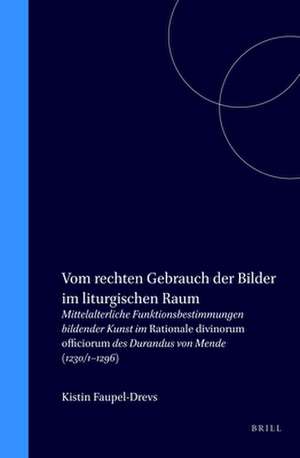Vom rechten Gebrauch der Bilder im liturgischen Raum: Mittelalterliche Funktionsbestimmungen bildender Kunst im Rationale divinorum officiorum des Durandus von Mende (1230/1-1296): Studies in the History of Christian Traditions, cartea 89
Autor Kirstin Faupel-Drevsde Limba Germană Hardback – 18 noi 1999
Din seria Studies in the History of Christian Traditions
- 18%
 Preț: 903.55 lei
Preț: 903.55 lei - 18%
 Preț: 1089.86 lei
Preț: 1089.86 lei - 18%
 Preț: 701.77 lei
Preț: 701.77 lei - 18%
 Preț: 832.26 lei
Preț: 832.26 lei - 15%
 Preț: 703.50 lei
Preț: 703.50 lei - 15%
 Preț: 521.73 lei
Preț: 521.73 lei - 18%
 Preț: 656.44 lei
Preț: 656.44 lei - 18%
 Preț: 1041.55 lei
Preț: 1041.55 lei - 18%
 Preț: 658.16 lei
Preț: 658.16 lei - 18%
 Preț: 658.72 lei
Preț: 658.72 lei - 18%
 Preț: 653.42 lei
Preț: 653.42 lei - 18%
 Preț: 661.04 lei
Preț: 661.04 lei - 18%
 Preț: 670.52 lei
Preț: 670.52 lei - 18%
 Preț: 658.78 lei
Preț: 658.78 lei - 18%
 Preț: 653.96 lei
Preț: 653.96 lei - 18%
 Preț: 654.19 lei
Preț: 654.19 lei - 18%
 Preț: 653.72 lei
Preț: 653.72 lei - 18%
 Preț: 653.26 lei
Preț: 653.26 lei - 18%
 Preț: 591.92 lei
Preț: 591.92 lei - 18%
 Preț: 661.11 lei
Preț: 661.11 lei - 18%
 Preț: 655.52 lei
Preț: 655.52 lei - 18%
 Preț: 660.74 lei
Preț: 660.74 lei - 18%
 Preț: 665.40 lei
Preț: 665.40 lei - 18%
 Preț: 656.84 lei
Preț: 656.84 lei - 18%
 Preț: 654.73 lei
Preț: 654.73 lei - 18%
 Preț: 656.29 lei
Preț: 656.29 lei - 18%
 Preț: 656.06 lei
Preț: 656.06 lei - 18%
 Preț: 645.00 lei
Preț: 645.00 lei - 18%
 Preț: 652.18 lei
Preț: 652.18 lei - 18%
 Preț: 669.60 lei
Preț: 669.60 lei - 18%
 Preț: 654.05 lei
Preț: 654.05 lei - 18%
 Preț: 654.58 lei
Preț: 654.58 lei - 18%
 Preț: 658.23 lei
Preț: 658.23 lei - 18%
 Preț: 655.03 lei
Preț: 655.03 lei - 18%
 Preț: 693.27 lei
Preț: 693.27 lei - 18%
 Preț: 693.27 lei
Preț: 693.27 lei - 18%
 Preț: 1372.84 lei
Preț: 1372.84 lei - 18%
 Preț: 695.60 lei
Preț: 695.60 lei - 18%
 Preț: 693.42 lei
Preț: 693.42 lei - 18%
 Preț: 1046.24 lei
Preț: 1046.24 lei - 18%
 Preț: 690.30 lei
Preț: 690.30 lei - 18%
 Preț: 690.55 lei
Preț: 690.55 lei - 18%
 Preț: 584.64 lei
Preț: 584.64 lei - 18%
 Preț: 693.27 lei
Preț: 693.27 lei - 18%
 Preț: 1249.53 lei
Preț: 1249.53 lei - 18%
 Preț: 692.11 lei
Preț: 692.11 lei - 18%
 Preț: 693.45 lei
Preț: 693.45 lei - 18%
 Preț: 692.03 lei
Preț: 692.03 lei - 18%
 Preț: 697.16 lei
Preț: 697.16 lei - 18%
 Preț: 680.67 lei
Preț: 680.67 lei
Preț: 658.40 lei
Preț vechi: 802.92 lei
-18% Nou
Puncte Express: 988
Preț estimativ în valută:
126.00€ • 131.06$ • 104.02£
126.00€ • 131.06$ • 104.02£
Carte indisponibilă temporar
Doresc să fiu notificat când acest titlu va fi disponibil:
Se trimite...
Preluare comenzi: 021 569.72.76
Specificații
ISBN-13: 9789004113152
ISBN-10: 9004113150
Pagini: 432
Dimensiuni: 155 x 235 x 35 mm
Greutate: 0.95 kg
Editura: Brill
Colecția Brill
Seria Studies in the History of Christian Traditions
ISBN-10: 9004113150
Pagini: 432
Dimensiuni: 155 x 235 x 35 mm
Greutate: 0.95 kg
Editura: Brill
Colecția Brill
Seria Studies in the History of Christian Traditions
Public țintă
All those interested in medieval Theology and Philosophie, history of the Church and Liturgy, history of Art, Semiotic.Cuprins
Vorwort
Einleitung: Standortbestimmung in der Gegenwart
I. TEIL. ZWISCHEN ORDO UND PRAXIS. DER AUTOR UND SEIN WERK
1. Durandus von Mende
2. Zur Quelle: Das Rationale divinorum officiorum. Ein liturgisches Handbuch und seine Vorläufer
3. Durandus’ Gebrauchsweise der Quellen im Rationale und erste Aspekte zum Themenbereich Kultus und Kunst
II. TEIL. DAS VERHÄLTNIS VON SIGNUM UND RES ODER DIE SPRACHE DER DINGE. HERMENEUTISCHE VORAUSSETZUNGEN
Einleitung
1. Sinnlichkeit und Sinn der res. Auf den Spuren mittelalterlichen Denkens
2. Die Zeichenlehre des Augustinus
3. Die umfassende Bildung des Menschen bei Hugo v. St. Viktor
III. TEIL. RATIO UND METHODE BEI DURANDUS. DER PROLOG
Einleitung
1. Anliegen und enzyklopädisches Konzept des Rationale
2. Semiotik im Rahmen des Sakramentsbegriffs
3. Figurative Hermeneutik
4. Zusammenfassung: Zur Korrespondenz von Semiotik und Allegorese
IV. TEIL. DIE BILDER IM LITURGISCHEN RAUM. RATIONALE I, III
1. Kirche als Bildraum. Die geistige Erschließung des materiellen Kirchenbaus (Rationale I, i und ii)
2. “Von den Malereien und Vorhängen und (sonstigen die Liturgie) schmückenden Gegenständen der Kirche” (Rationale I, iii)
V. TEIL. ZUSAMMENFASSUNG UND ERGEBNISSE. VOM RECHTEN GEBRAUCH DER BILDER IM LITURGISCHEN RAUM
1. Zusammenfassung der hermeneutischen Grundlagen
2. Die Funktionen der Bilder im liturgischen Raum
3. Der “Kunstbegriff ” bei Durandus
ANHANG
1. Übersetzungen
2. Quellen- und Literaturverzeichnis
3. Register
Einleitung: Standortbestimmung in der Gegenwart
I. TEIL. ZWISCHEN ORDO UND PRAXIS. DER AUTOR UND SEIN WERK
1. Durandus von Mende
2. Zur Quelle: Das Rationale divinorum officiorum. Ein liturgisches Handbuch und seine Vorläufer
3. Durandus’ Gebrauchsweise der Quellen im Rationale und erste Aspekte zum Themenbereich Kultus und Kunst
II. TEIL. DAS VERHÄLTNIS VON SIGNUM UND RES ODER DIE SPRACHE DER DINGE. HERMENEUTISCHE VORAUSSETZUNGEN
Einleitung
1. Sinnlichkeit und Sinn der res. Auf den Spuren mittelalterlichen Denkens
2. Die Zeichenlehre des Augustinus
3. Die umfassende Bildung des Menschen bei Hugo v. St. Viktor
III. TEIL. RATIO UND METHODE BEI DURANDUS. DER PROLOG
Einleitung
1. Anliegen und enzyklopädisches Konzept des Rationale
2. Semiotik im Rahmen des Sakramentsbegriffs
3. Figurative Hermeneutik
4. Zusammenfassung: Zur Korrespondenz von Semiotik und Allegorese
IV. TEIL. DIE BILDER IM LITURGISCHEN RAUM. RATIONALE I, III
1. Kirche als Bildraum. Die geistige Erschließung des materiellen Kirchenbaus (Rationale I, i und ii)
2. “Von den Malereien und Vorhängen und (sonstigen die Liturgie) schmückenden Gegenständen der Kirche” (Rationale I, iii)
V. TEIL. ZUSAMMENFASSUNG UND ERGEBNISSE. VOM RECHTEN GEBRAUCH DER BILDER IM LITURGISCHEN RAUM
1. Zusammenfassung der hermeneutischen Grundlagen
2. Die Funktionen der Bilder im liturgischen Raum
3. Der “Kunstbegriff ” bei Durandus
ANHANG
1. Übersetzungen
2. Quellen- und Literaturverzeichnis
3. Register
